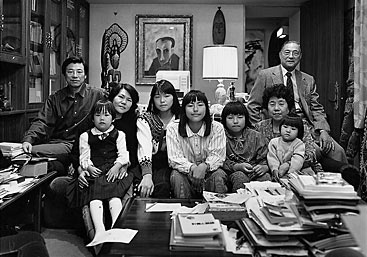
Born in 1954 in Gedern (DE)
Lives and works in Düsseldorf (DE)

1987
Black and white photograph, gelatin-silver print
52 x 68 cm
Year of Purchase: 1990
‘We are endlessly confronted with quantities of phenomena whose causes it becomes harder and harder to determine.’1
As a student of the Bechers at the Kunstakademie in Düsseldorf, and influenced by Gerhard Richter’s research on photographic representation, Thomas Struth fully incorporates the technical means of the medium in his conceptual approach, so as to show the specific capacity of the image to make sense. He thus casts a neutral and somewhat remote eye on the world and its inhabitants, photographing them with great impartiality, as an observer of the state of things.
In 1975, he started systematically to photograph streets in Europe, the United States and Japan, thus tracking down fragments of reality and living conditions, in the time the shot is taken. This study, followed in 1986 by a series of household portraits, turns its back on any kind of effect-related expressiveness, any inner drama projected in the creative act, any presence on the part of the artist, to blend in with the objectivity of the systematic sampling. Without any aesthetic or documentary content, reducing the depth of field, and the randomness of light and perspective, Struth’s work casts a reasoned eye on things, while leaving the space photographed open to the proliferation of the living. With a symbolic and social content which distinguishes them from the cold and objective trend of German photography (Becher, T. Ruff…), Struth’s images reflect the wealth of history and the forms of socio-political determinism within cultural spaces.
The aligned buildings of Hubertusstrasse show the inhumanity of postwar buildings in Germany, in which we can read guilt and loss of history; Shibuya-ku is just an accumulation of signs and movements; The Hirose Family shows the codes of social and cultural representation of a Japanese family from Hiroshima… At the heart of being in the world, Thomas Struth verifies the behaviour and movement etched in the structure of cities whose many scars tell of this unconscious encounter between history and its future.
Maïté Vissault
1 Thomas Struth, interview with G.Minelli in ‘Une nouvelle objectivité’, Milan: Idea Book, 1989, p.191.